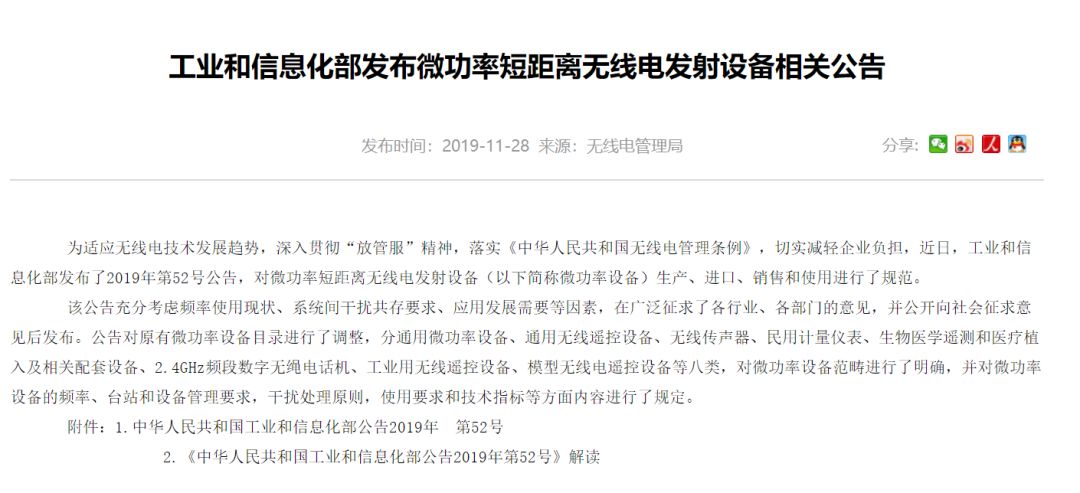
Author: Zhao Xiaofei
IoT Think Tank Original
Please indicate the source and origin when reprinting

Introduction
Yesterday, the official website and WeChat account of the Ministry of Industry and Information Technology (MIIT) publicly released the “Announcement on Low-Power Short-Distance Radio Transmission Equipment” (Announcement No. 52 of 2019). After nearly two years since December 2017, the regulatory system for low-power devices has finally been established. This article will interpret it from four aspects.

Yesterday, the MIIT officially released the “Announcement on Low-Power Short-Distance Radio Transmission Equipment” (Announcement No. 52 of 2019) (hereinafter referred to as Announcement No. 52), marking the long-awaited regulation of low-power devices.

In recent years, the rapidly developing Low Power Wide Area Network (LPWAN) in the IoT field, especially devices using unlicensed spectrum, falls under this regulatory framework. Therefore, the release of this announcement has inevitably sparked heated discussions in the industry, with various opinions flooding in, and many viewpoints directly targeting LoRa, reflecting both favorable and unfavorable perspectives on it. In this regard, we can interpret it from the following four aspects:
1. Misconceptions? LoRa and Low-Power Devices Are Not the Same
This announcement targets low-power devices, meaning all devices defined by the regulatory authority as low-power will fall under this announcement’s regulatory scope.
The MIIT’s announcement clearly states: The announcement adjusts the existing low-power device catalog, categorizing it into eight types: general low-power devices, general wireless remote control devices, wireless microphones, civilian measuring instruments, biomedical telemetry and medical implants and related supporting devices, 2.4GHz digital cordless phones, industrial wireless remote control devices, and model radio remote control devices, clarifying the scope of low-power devices.
It is evident that low-power devices encompass a wide range of eight categories, all within the regulatory scope of Announcement No. 52. The “Catalog of Low-Power Short-Distance Radio Transmission Equipment” provides clear definitions for each category of devices, although there is no explicit definition for distance, due to clear definitions for frequency bands, transmission power, bandwidth, and other indicators, devices using Sub 1GHz spectrum such as LoRa, ZETA, Weightless, and unlicensed spectrum NB-IoT as well as other self-developed low-power wide-area network devices must comply with this regulation.
Additionally, the MIIT mentioned in the policy interpretation of this announcement: As early as 1998, the former Ministry of Information Industry issued specific regulatory measures for low-power devices, which were revised in 2005. This current revision is based on the previous regulatory measures, reflecting the latest spirit of the “Radio Management Regulations” and the new developments in the market.
Thus, low-power devices are not a new concept; they have been widely used in various sectors of the national economy for over 20 years, and the government has implemented specific regulatory systems, such as for numerous wireless remote control toys, model aircraft, small broadcasting devices, medical electronics, industrial remote controls, etc. With economic development, the number of these devices is in the hundreds of millions.
The release of Announcement No. 52 applies to all low-power devices. It is well known that LoRa-related technologies and products emerged in France and the United States in recent years, entering China around 2013. From this perspective, LoRa-related devices are just a small part of the many low-power devices, and the strict regulatory requirements set forth in Announcement No. 52 apply to various low-power devices, while some industry voices elevate it to merely regulating LoRa, which clearly suggests a tendency to generalize and misinterpret.
2. Legal Basis, Announcement Provides Framework for Market Behavior
In my view, the MIIT’s formal announcement of the “Technical Requirements for Low-Power Short-Distance Radio Devices” gives this standard legal efficacy.This is not a